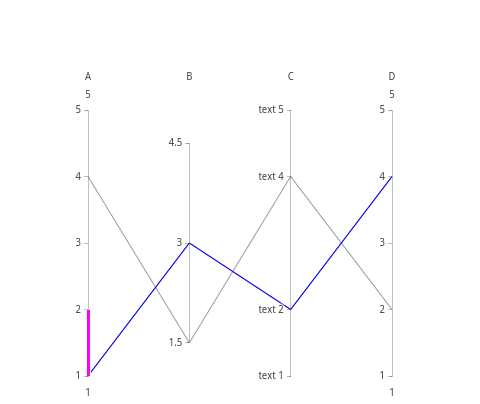NAME
Chart::Plotly::Trace::Parcoords - Parallel coordinates for multidimensional exploratory data analysis. The samples are specified in `dimensions`. The colors are set in `line.color`.
VERSION
version 0.033
SYNOPSIS
use Chart::Plotly qw(show_plot);
use Chart::Plotly::Trace::Parcoords;
# Example data from: https://plot.ly/javascript/parallel-coordinates-plot/#adding-dimensions
my $parcoords = Chart::Plotly::Trace::Parcoords->new(
line=> {
color=> 'blue'
},
dimensions=> [{
range=> [1, 5],
constraintrange=> [1, 2],
label=> 'A',
values=> [1,4]
}, {
range=> [1,5],
label=> 'B',
values=> [3,1.5],
tickvals=> [1.5,3,4.5]
}, {
range=> [1, 5],
label=> 'C',
values=> [2,4],
tickvals=> [1,2,4,5],
ticktext=> ['text 1','text 2','text 4','text 5']
}, {
range=> [1, 5],
label=> 'D',
values=> [4,2]
}]
);
show_plot([ $parcoords ]);DESCRIPTION
Parallel coordinates for multidimensional exploratory data analysis. The samples are specified in `dimensions`. The colors are set in `line.color`.
Screenshot of the above example:

This file has been autogenerated from the official plotly.js source.
If you like Plotly, please support them: https://plot.ly/ Open source announcement: https://plot.ly/javascript/open-source-announcement/
Full reference: https://plot.ly/javascript/reference/#parcoords
DISCLAIMER
This is an unofficial Plotly Perl module. Currently I'm not affiliated in any way with Plotly. But I think plotly.js is a great library and I want to use it with perl.
METHODS
TO_JSON
Serialize the trace to JSON. This method should be called only by JSON serializer.
type
Trace type.
ATTRIBUTES
customdata
Assigns extra data each datum. This may be useful when listening to hover, click and selection events. Note that, *scatter* traces also appends customdata items in the markers DOM elements
customdatasrc
Sets the source reference on plot.ly for customdata .
dimensions
domain
ids
Assigns id labels to each datum. These ids for object constancy of data points during animation. Should be an array of strings, not numbers or any other type.
idssrc
Sets the source reference on plot.ly for ids .
labelangle
Sets the angle of the labels with respect to the horizontal. For example, a `tickangle` of -90 draws the labels vertically. Tilted labels with *labelangle* may be positioned better inside margins when `labelposition` is set to *bottom*.
labelfont
labelside
Specifies the location of the `label`. *top* positions labels above, next to the title *bottom* positions labels below the graph Tilted labels with *labelangle* may be positioned better inside margins when `labelposition` is set to *bottom*.
line
pmeta
Assigns extra meta information associated with this trace that can be used in various text attributes. Attributes such as trace `name`, graph, axis and colorbar `title.text`, annotation `text` `rangeselector`, `updatemenues` and `sliders` `label` text all support `meta`. To access the trace `meta` values in an attribute in the same trace, simply use `%{meta[i]}` where `i` is the index or key of the `meta` item in question. To access trace `meta` in layout attributes, use `%{data[n[.meta[i]}` where `i` is the index or key of the `meta` and `n` is the trace index.
metasrc
Sets the source reference on plot.ly for meta .
name
Sets the trace name. The trace name appear as the legend item and on hover.
rangefont
stream
tickfont
transforms
uid
Assign an id to this trace, Use this to provide object constancy between traces during animations and transitions.
uirevision
Controls persistence of some user-driven changes to the trace: `constraintrange` in `parcoords` traces, as well as some `editable: true` modifications such as `name` and `colorbar.title`. Defaults to `layout.uirevision`. Note that other user-driven trace attribute changes are controlled by `layout` attributes: `trace.visible` is controlled by `layout.legend.uirevision`, `selectedpoints` is controlled by `layout.selectionrevision`, and `colorbar.(x|y)` (accessible with `config: {editable: true}`) is controlled by `layout.editrevision`. Trace changes are tracked by `uid`, which only falls back on trace index if no `uid` is provided. So if your app can add/remove traces before the end of the `data` array, such that the same trace has a different index, you can still preserve user-driven changes if you give each trace a `uid` that stays with it as it moves.
visible
Determines whether or not this trace is visible. If *legendonly*, the trace is not drawn, but can appear as a legend item (provided that the legend itself is visible).
AUTHOR
Pablo Rodríguez González <pablo.rodriguez.gonzalez@gmail.com>
COPYRIGHT AND LICENSE
This software is Copyright (c) 2019 by Pablo Rodríguez González.
This is free software, licensed under:
The MIT (X11) License